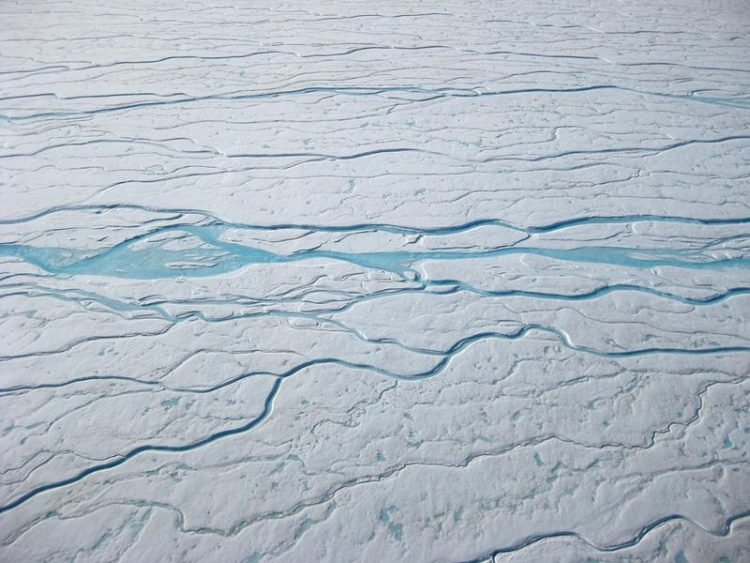Meltwater from the Greenland ice sheet releasing faster

Meltwater rivers on the Greenland ice sheet. Dirk van As, Geological Survey of Denmark and Greenland
The near-surface layers of the Greenland ice sheet are made up of snow that is gradually being converted into glacier ice. In Greenland this firn layer is up to 80 m thick.
As researchers from Denmark, the USA and the University of Zurich have demonstrated, the current atmospheric warming is changing this firn layer such that resulting meltwater is being released faster than previously anticipated.
“Basically our research shows that the firn reacts fast to a changing climate. Its ability to limit mass loss of the ice sheet by retaining meltwater could be smaller than previously assumed”, sums up Horst Machguth, lead author of the study by the University of Zurich.
The researchers travelled to Greenland to investigate the impact of recent atmospheric warming on the structure of near-surface snow and ice layers, called firn. Over the course of three expeditions on the ice sheet, the researchers traversed several hundred kilometres to map the structure of the firn layers with a radar unit and by drilling regularly-spaced firn cores.
Firn layer acts sponge-like
Earlier research has shown that the firn layer acts similar to a sponge. It stores meltwater percolating down into the firn from the surface in what are referred to as ‘ice lenses’. “It is unknown how the firn reacted to the recent very warm summer in Greenland. Our research aims to clarify whether the firn was indeed capable of retaining the meltwater, or whether the sponge has been overwhelmed.”
The scientists drilled numerous 20 metre-deep cores to sample the firn, also targeting sites where similar cores had been drilled 15 to 20 years ago. At many locations, a comparison of the new and old cores revealed substantially more ice lenses than in the past and that the firn stored the meltwater similar to a sponge. But this was not the case everywhere. Cores drilled at lower elevations indicated that the exceptional amounts of meltwater formed a surprisingly massive ice layer directly below the ice sheet surface.
Meltwater no longer percolating
“It appears that the intensive and repeated entry of meltwater formed numerous ice lenses, which ultimately hindered percolation of further meltwater”, says Dirk van As, a co-author of the study from the Geological Survey in Denmark and Greenland. As a result, the many small lenses grew to form an ice layer of several meters in thickness that now acts as a lid on top of otherwise sponge-like firn.
Radar measurements identified that this layer was continuous over dozens of kilometers. New meltwater, hitting that lid of ice was unable to percolate into the firn and remained at the surface. Satellite imagery shows that the water prevented from percolating collected at the surface, where it formed rivers that flow towards the margin of the ice sheet.
“In contrast to storing meltwater in porous firn, this mechanism increases runoff from the ice sheet”, explains Mike MacFerrin, second-author of the study and a researcher at the University of Colorado at Boulder.
“This process has not previously been observed in Greenland. The total extent of this ice lid capping the ice sheet firn remains unknown. For this reason, the amount of additional ice sheet runoff associated with this newly observed process cannot yet be quantified.” However, similar changes in firn structure have already been observed in the Canadian Arctic, which leads to the conclusion that this phenomenon could be widespread.
Literature:
Machguth, H., M. MacFerrin, D. van As, J. E. Box, C. Charalampidis, W. Colgan, R. S. Fausto, H. A. J. Meijer, E. Mosley-Thompson and R. S. W. van de Wal. Greenland meltwater storage in firn limited by near-surface ice formation. Nature Climate Change. Doi: 10.1038/NCLIMATE2899
http://nature.com/articles/doi:10.1038/nclimate2899
Contacts:
Horst Machguth
World Glacier Monitoring Service
Department of Geography
University of Zurich.
Phone: +41446355119
Email: horst.machguth@geo.uzh.ch
Dirk van As
Geological Survey of Denmark and Greenland (GEUS) Copenhagen, Denmark
Phone: +4591333818
Email: dva@geus.dk
Michael MacFerrin
Cooperative Institute for Research in Environmental Sciences (CIRES)
University of Colorado at Boulder, USA
Phone: 1-303-565-9920
Email: michael.macferrin@colorado.edu
Media Contact
More Information:
http://www.uzh.ch/All latest news from the category: Earth Sciences
Earth Sciences (also referred to as Geosciences), which deals with basic issues surrounding our planet, plays a vital role in the area of energy and raw materials supply.
Earth Sciences comprises subjects such as geology, geography, geological informatics, paleontology, mineralogy, petrography, crystallography, geophysics, geodesy, glaciology, cartography, photogrammetry, meteorology and seismology, early-warning systems, earthquake research and polar research.
Newest articles

Properties of new materials for microchips
… can now be measured well. Reseachers of Delft University of Technology demonstrated measuring performance properties of ultrathin silicon membranes. Making ever smaller and more powerful chips requires new ultrathin…

Floating solar’s potential
… to support sustainable development by addressing climate, water, and energy goals holistically. A new study published this week in Nature Energy raises the potential for floating solar photovoltaics (FPV)…

Skyrmions move at record speeds
… a step towards the computing of the future. An international research team led by scientists from the CNRS1 has discovered that the magnetic nanobubbles2 known as skyrmions can be…




















